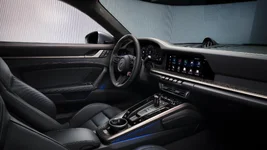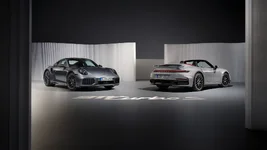Porsche is presenting the top-of-the-range model of the 911 series at the IAA Mobility motor show in Munich: an innovative twin-turbo powertrain with T-Hybrid technology makes the new 911 Turbo S the most powerful production 911 to date.
The new Porsche 911 Turbo S is following in big footsteps. Its predecessor was already considered the benchmark in the sports car world when it came to combining performance, long-distance comfort, exclusivity and everyday usability. Now, the 911 Turbo S has once again raised the bar significantly in all areas. The sports car, which is available as a coupé and cabriolet, debuts with significantly increased performance, a more powerful design, more intelligent aerodynamics, an optimized chassis and even more exclusive equipment.
"The 911 Turbo S is the most complete and versatile form of driving a Porsche 911. Whether in daily use, on long autobahn journeys or on the racetrack – we have made the new 911 Turbo S even more comfortable, more individual and significantly faster than its predecessor," says Frank Moser, Vice President of the 911 and 718 model line.
Innovative Twin-Turbo T-Hybrid powertrain
The newly developed, high-performance powertrain achieves a system output of 523 kW (711 PS). This makes the new 911 Turbo S the most powerful production 911 to date. The maximum torque of the powertrain is 800 Nm and is available over an extremely wide range of 2,300 to 6,000 rpm. The power curve is also characterised by an unusually broad peak: between 6,500 and 7,000 crankshaft revolutions, the full power of 711 PS is available. Equipped with the innovative and particularly lightweight T-Hybrid technology with a 400 V system, it increases power by 61 PS compared to its predecessor.
A T-Hybrid powertrain first debuted in 2024 in the 911 Carrera GTS. The technology has since been significantly further developed for use in the new 911 Turbo S. While a single electric exhaust gas turbocharger (eTurbo) is integrated into the T-Hybrid system in the GTS, two eTurbos are used in the new 911 Turbo S. The turbine and compressor were specifically designed to meet the requirements of the top-of-the-range model. The two eTurbos contribute not only to the considerable increase in performance, but also improve the responsiveness of the powertrain.
The particularly compact lightweight high-voltage battery with a capacity of 1.9 kWh is the same as that used in the 911 Carrera GTS (911 Carrera GTS: Fuel consumption* combined (WLTP) 11.0 – 10.4 l/100 km, CO₂ emissions* combined (WLTP) 248 – 236 g/km, CO₂ class G , CO₂ class weighted combined G ). An eight-speed PDK with an integrated electric motor transmits the power to the Porsche Traction Management (PTM) all-wheel drive system. The Turbo S Coupé's sprint time of 0-100 km/h is reduced by 0.2 seconds to 2.5 seconds compared to its predecessor. It takes just 8.4 seconds to reach 200 km/h, which represents an improvement of 0.5 seconds. The top speed of the new 911 Turbo S is 322 km/h.
Around 14 seconds faster on the Nürburgring Nordschleife
Despite the additional components of the performance hybrid system, the new 911 Turbo S weighs just 85 kilograms more than its predecessor. The increase in weight has been more than compensated for in all areas relevant to driving dynamics. The best demonstration of this is the lap time on the Nürburgring Nordschleife. As part of the final development drives conducted in autumn 2024, a lightly camouflaged 911 Turbo S achieved a time of 7:03.92 minutes under notarial supervision – around 14 seconds faster than its predecessor. "You don't feel the weight gain. On the contrary – the car is much more agile, has more grip and is significantly faster than its predecessor in all relevant sections of the track," says Porsche Brand Ambassador Jörg Bergmeister, who was involved in the development and testing of the new 911 Turbo S and set the official lap time.
Brakes and tyres with optimised performance
Porsche’s engineers implemented upgrades across all areas to achieve the impressive performance of the top-of-the-range 911 model. The new generation of tyres used in the 911 Turbo S offers significantly improved dry handling while maintaining good performance in the wet. The rear axle of the sports car is now fitted with 10 millimetres wider tyres compared to the previous model, measuring 325/30 ZR 21. As with its predecessor 255/35 ZR 20 size tires are mounted on the front axle. The standard Porsche Ceramic Composite Brake (PCCB) system is fitted with new brake pads and can withstand enormous loads. This improves braking performance and pedal feel in equal measure. The engineers increased the brake disc diameter on the rear axle from 390 mm to 410 mm. Brake discs with a diameter of 420 mm are used at the front. This means that the new 911 Turbo S is equipped with the largest PCCB brake system that Porsche has ever installed in a two-door model.
Intelligent active aerodynamics
Enhanced aerodynamics optimise the cooling and efficiency of the new 911 Turbo S. Active, vertically arranged cooling air flaps at the front of the vehicle and an active front diffuser, together with an adjustable front spoiler lip and the extendable and tilting rear wing carried over from the predecessor, work together as an efficient overall system. Cooling air flows optimally to the brakes and radiators. Depending on the driving situation, the active aerodynamics intelligently reduce lift or, when retracted, drag. The drag coefficient of the 911 Turbo S Coupé has been reduced by 10 per cent compared to its predecessor, when all active aerodynamic elements are in their most efficient position. In addition, the active aerodynamics improve the wet braking performance of the top model: in wet mode, the front diffusers close to shield the front brake discs from excessive water spray.
Chassis for improved agility and stability
The T-Hybrid powertrain with its high-voltage electrical system and battery system allows Porsche engineers to equip the 911 Turbo S with electro-hydraulically controlled Porsche Dynamic Chassis Control (ehPDCC) as standard. It reduces the tendency to roll when changing direction and increases agility when entering and exiting corners. The system works with cross-connected, active coupling rods, in which pressure is built up by oil volume flow depending on the driving situation. The stabilizers generate support forces and keep the vehicle in balance. This makes the sports car even more predictable and easier to drive despite the enormous power. This improves both driving comfort and driving dynamics. As a result, the top model of the 911 model series improves further in driving comfort, stability and agility at the same time. For optimum everyday usability, the electrohydraulic PDCC is available with an optional lift system for the front axle, which acts much faster than its predecessor thanks to its integration into the 400 V system.
A new standard sports exhaust system with rear silencer and tailpipe trims made of titanium also underscores the position of the 911 Turbo S acoustically. Its sound was composed especially for the top model. In addition, the exhaust system saves 6.8 kg of weight. Internal engine modifications are another factor contributing to the even more emotive sound. The 3.6-litre boxer engine works specifically with asymmetrical timing that adds further frequencies to the engine, creating a more throaty and distinctive sound typical of a boxer engine.
Exclusive look and high-quality equipment
The new Turbo S marks the introduction of Porsche's cross-series Turbo design strategy in the 911. Numerous contrasting elements are finished in the colour Turbonite, which is reserved exclusively for Turbo variants. These include the Porsche crest and the Turbo S lettering at the rear. In addition, Turbo S-specific inserts in the slats of the rear wing and the side window strips differentiate the top-of-the-range model. The range of wheels for the Turbo S includes new centre-lock designs in Turbonite.
As is typical for the Turbo, the new top-of-the-range model of the current 911 series has a visibly wider body and track compared to the Carrera models, as well as openings in the rear side section. On the redesigned rear fascia, striking ventilation openings additionally emphasise the width. The tailpipes of the titanium exhaust system in a newly interpreted design typical of the Turbo underscore the car's position in the model line, as does a dynamic pearl structure above the taillight strip. Oval titanium tailpipe trims with a special structure are available as an option. Overall, its exclusive appearance clearly differentiates the Turbo S from other 911 models.
Turbonite accents also characterise the interior. They can be found in the door panels, on the steering wheel, dashboard and centre console surrounds, as decorative stitching, and on the Sport Chrono stopwatch and instrument cluster. Porsche’s designers have also used the colour for the seat belts and several buttons in the center console. For the first time, carbon-structured trim strips with neodyme trim and a perforated microfiber headliner with black backing are part of the exclusive interior.
As a coupé, the 911 Turbo S is delivered as a two-seater as standard. On request, the rear seat system can be configured at no extra charge. The cabriolet is delivered in a 2+2 configuration. Porsche equips the new 911 Turbo S with HD Matrix LED headlights as standard. They feature innovative light functions that increase safety noticeably when driving at night. The Sport Chrono Package including tyre temperature gauge, the specifically tuned PASM suspension, the PDCC electro-hydraulic roll support and the titanium sports exhaust system are also standard equipment. In the interior, Adaptive 18-way Sports Seats Plus with memory function and "turbo S" lettering on the headrests are used ex works. The Turbo S-specific embossing on the seat surfaces and door panels is a reinterpretation of the design features of the first 911 Turbo 930. The folding lightweight sports bucket seat familiar from the 911 GT3 is available as an option for the coupé.
Wide range of options
Further customisation options are available via the Porsche Exclusive Manufaktur range. In addition to the Paint to Sample programme with more than 100 exterior colours, these options include Turbo Exclusive Design wheels with carbon blades painted in Neodyme, a lightweight roof in visible carbon, Exclusive Design rear lights and air intakes in the rear side section made of carbon. For the first time, lightweight wiper arms made of carbon, which are 50 per cent lighter than the standard component, can be ordered. The interior can be further enhanced with details such as decorative stitching in contrasting colours, personalised embossing, seat consoles and sill panels in leather with fine decorative stitching, as well as personalised painted vehicle keys.
The 911 Turbo S for the wrist
The Porsche Design Timepieces Configurator offers customers the possibility of designing their own personal sports car for the wrist – perfectly matching the 911 Turbo S down to the last detail. The new black dial with design Turbonite elements reflects this close connection to the vehicle. In addition to Turbonite, all exterior colours (including Paint to Sample) are available for the colour ring around the dial.
The titanium case features a black titanium carbide coating. The strap is made of original Porsche interior leather and yarn. A highlight is the hot stamping with the Turbo S lettering. The timepiece is powered by the Porsche Design caliber WERK 01.200 with COSC certification and flyback function. The customisable winding rotor echoes the various designs of the 911 Turbo S wheels and features the Porsche crest in Turbonite. The case back can be personalised with an engraving. The Chronograph 911 Turbo S is handmade to order in Porsche's watch manufactory in Grenchen, Switzerland.
Continue reading...
911 Turbo S (preliminary values): Fuel consumption* combined (WLTP) 11.8 – 11.6 l/100 km, CO₂ emissions* combined (WLTP) 266 – 262 g/km, CO₂ class G , CO₂ class weighted combined G , 911 Turbo S Cabriolet (preliminary values): Fuel consumption* combined (WLTP) 11.8 – 11.7 l/100 km, CO₂ emissions* combined (WLTP) 267 – 265 g/km, CO₂ class G , CO₂ class weighted combined G


















































